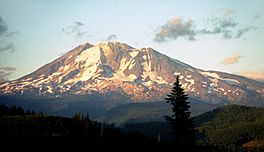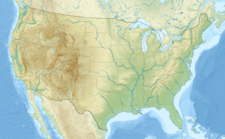Avalanche Glacier facts for kids
Quick facts for kids Avalanche Glacier |
|
|---|---|

Avalanche Glacier can be seen in the center of the photo. It is fed by the White Salmon Glacier, which is located to the upper-left of Avalanche Glacier.
|
|
| Type | Mountain glacier |
| Coordinates | 46°11′04″N 121°30′36″W / 46.18444°N 121.51000°W |
| Area | 0.86 km2 (0.33 sq mi) in 2006 |
| Length | 1 mi (1.6 km) |
| Terminus | Talus |
| Status | Retreating |
The Avalanche Glacier is a cool natural ice formation found on the west and southwest sides of Mount Adams. Mount Adams is a large stratovolcano (a cone-shaped volcano built up by many layers of hardened lava and ash) located in the Gifford Pinchot National Forest in the state of Washington, USA. This glacier gets its ice from the White Salmon Glacier, which sits higher up the mountain.
Contents
What is Avalanche Glacier?
Avalanche Glacier is a type of glacier called a mountain glacier. It's a huge, slow-moving river of ice. This glacier starts high up on Mount Adams, around 10,200 feet (about 3,100 meters) above sea level. It then flows down the mountain to an end point, or terminus, near 7,600 feet (about 2,300 meters).
How Glaciers Form
Glaciers form when snow falls in one place and doesn't melt completely over many years. Each new layer of snow presses down on the layers below it. This pressure turns the snow into dense ice. Over time, this ice becomes so heavy that it starts to flow slowly downhill, like a very thick, frozen river.
Where is Avalanche Glacier Located?
Avalanche Glacier is on Mount Adams, a big volcano in the Cascade Range. This mountain is part of the Gifford Pinchot National Forest, a large protected area in Washington state. The glacier is specifically in Yakima County, Washington. Its location means it's high up where temperatures stay cold enough for ice to form and last.
Size and Retreat of Avalanche Glacier
Avalanche Glacier is about 1 mile (1.6 kilometers) long. In 2006, its surface area was about 0.86 square kilometers (0.33 square miles). However, this glacier has been getting smaller for more than 100 years. This process is called retreating.
Why Glaciers Retreat
When a glacier retreats, it means its ice is melting faster than new snow can turn into ice and add to it. Avalanche Glacier has lost a lot of its size. Between 1904 and 2006, it shrank by 59 percent of its surface area. This retreat is mainly due to warmer temperatures, which are part of climate change. As the Earth's climate warms, glaciers around the world are melting at a faster rate.
Impact of Glacier Retreat
The shrinking of glaciers like Avalanche Glacier can have several effects. Glaciers are important sources of fresh water for rivers and streams, especially during dry seasons. When they melt, they contribute to rising sea levels. Their retreat also changes the landscape and affects the plants and animals that live in these cold environments. Studying glaciers helps scientists understand more about our planet's climate.
Images for kids




